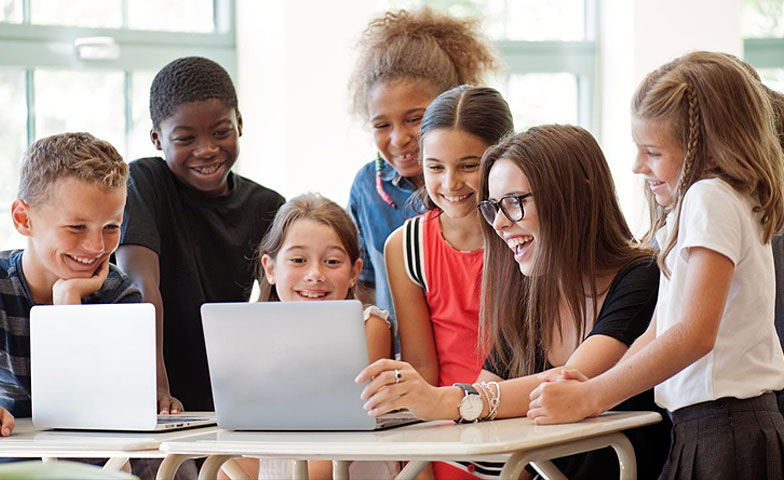Students—and teachers—are more creative and open to learning when our classrooms are joyful
As societal pressures intensify and expectations push educators to improve achievement rates, create emotionally healthy environments, and make safety a priority, there is an increasing need to infuse joy into the classroom. Reflecting on these concerns throughout my 29 years in education, I am prompted to consider joy and its relationship to my life and work.
Joy, defined as a noun, is an expression of emotion, display of great delight or keen pleasure. I recognize and feel great joy when I am out in nature, when I engage in activities and laughter with family, when I accomplish a task, and when I see others experience delight. Thinking about joy in these contexts inspires me to ask: when do I feel, experience, and share joy in my own classroom?
Recent brain research reveals that the brain is increasingly open to learning when learning is joyful. When we feel delight, we release endorphins that produce a joy-filled response (Costa & Kallick, 2014). A positive classroom climate is built through everyday teacher and student connections and interactions (Badley, 2012). These moments are not just brief warm fuzzies; they reap positive results on an individual’s health, both physically and psychologically (Costa & Kallick, 2014).
Reflecting on joy has revealed three areas of joy in my classroom: the first is when students have that light-bulb or “ah-ha” moment. My heart actually races faster when I see a student discover and grasp a new concept, complete a project, and “get it!” I am filled with immense joy when an engaged student asks a thoughtful question; furthermore, when joy emerges, student curiosity grows.
In addition to the “ah-ha” moment, I am filled with immeasurable joy when I hear laughter in the classroom. When a student says something funny, I can choose to stop and pause, to laugh with or laugh alongside the student. I find that I also need to pause and laugh at myself when teaching. When I am tongue-tied or when I make a mistake delivering instruction, the space is optimal for me to pause and laugh a little. Laughter can diffuse an awkward situation and increase the level of classroom joy.
Additionally, when I am able to laugh at myself, I am able to reveal a playful side of my personality to students. Research suggests that playfulness and creativity elicit joy that positively impacts student and teacher attitudes in the classroom (Sherman, 2013; Silver, Berckemeyer, & Baenen, 2015). I find that when there is laughter in my classroom—my students and I laugh together—joy multiplies! Classroom laughter fosters joyful space, for both students and teacher, to learn and grow.
Another avenue for joy is when I observe students working together. I am filled with joy and satisfaction when a lesson clicks and learning happens. When students engage in meaningful work, it is joyful to observe (Sherman, 2013; Silver, Berckemeyer, & Baenen, 2015, p. 93). When students collaborate and progress together in academic goals, they become eager sponges engaging in joyful learning.
Practically speaking, I offer three suggestions for infusing joy into your classroom:
Invite joy into the classroom! When you feel joy, dive into it, embrace it, and welcome it. An invitation is a literal request and summons for participation. Teachers can invite students to embrace joy in the classroom to build community and create ownership. Students will cling to joy and this can alter your classroom ethos.
Build on the student-teacher relationship! When a teacher intentionally builds trust and rapport with students, she creates a safe place and space for joy to emerge. Birky (2012) writes of modeling joy in the classroom to create joyful results. When a teacher creates assignments where students can share ideas and infuse laughter, joy multiplies.
Be joyfully intentional! Carefully consider what elicits joy in your teacher-self: name it, repeat it, and practice it. With great intention, capitalize on joyful moments. Joy is contagious. Infusing joy with purpose can decrease student and teacher stress, foster community, and help students feel a greater sense of belonging. A teacher can actively create moments for joy and rejoicing in the classroom; by doing so, the teacher shares the gift of herself with her students (Wineberg, 2012).
As classroom responsibilities, pressures, and expectations grow, teachers can make an increased effort to invite joy into the classroom, build on the student and teacher relationship, and purposefully share joy. Tomlinson suggests that when hard working teachers embrace creativity in their personal and professional lives, they seek joy and opportunities for laughter and learning (2016, p. 93).
Will you intentionally cultivate joy in your classroom? Will you allow joy to emerge into your work and lessons? Will you make an effort to demonstrate joy? Let’s commit to lean into joy and watch our classrooms fill with joy!
References
Badley, K. (2012). Metaphors and models of faith learning integration. In Badley, K. & Van Brummelen, H.V., (Eds.), Metaphors we teach and live by, how metaphors shape what we do in classrooms, (p. 139-157). Eugene, OR: Wipf & Stock.
Birky, G. D. (2012). Joy. In Dee, A. L. & Tiffin, G., (Eds.), Faithful education, these and values for teaching, learning and leading, (p. 19-41). Eugene, OR: Pickwick Publication.
Costa, A. L. & Kallick, B. (2014). Dispositions: Reframing teaching and learning. Thousand Oaks, CA: Corwin.
Silver, D., Berckemeyer, J. C., & Baenen, J. (2015). Deliberate optimism, reclaiming the joy in education. Thousand Oaks, CA: Corwin.
Sherman, S. M. (2013). Let’s lighten up! Play and important roles in learning. Virginia Journal of Education, 4, 13-15.
Tomlinson, C. A. (2016). Caring for teachers. Educational Leadership, 73(8), p. 92-3.
Wineberg, T. (2012). Metaphors for teaching and learning. In Badley, K. & Van Brummelen, H., (Eds.), Metaphors we teach by, how metaphors shape what we do in Classrooms, (p. 32-51). Eugene, OR: Wipf & Stock.
